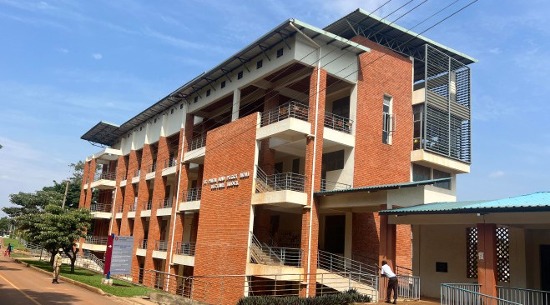By Timothy Okurut
The Stephen and Peggy Noll Block building also known as the “Noll Block,” was officially opened on the 29th October, 2015 in honour of Stephen and Peggy Noll, the first Vice Chancellor of Uganda Christian University (UCU) and his wife for their outstanding service to the UCU community. The major purpose of the project was to increase space for lectures and learning due to the increasing number of students who were being admitted.
The building is situated at the heart of the university, standing to the left of the driveway below the Honors College residences. At four floors, the Noll Block is UCU’s tallest building, and by standing on its fourth floor, one is able to have a wide view of a huge portion of the university environment. The Noll Block is the biggest classroom block housing at least three classrooms on each floor. It is also fitted with a closed-circuit television (CCTV) system that helps in surveillance, giving the building a boost in terms of security. Its classrooms are spaciously built and have readily installed projectors that aid digital teaching and learning. It also has a split section with two floors which was designated specifically for computer laboratories.
The block provides signage, ramps, handrails, squat toilets with grab bars and tactile markers to accommodate people with disabilities and according to the law.
Why Prof. Stephen and Peggy Noll
In an interview with the Rev. Canon Dr. John Senyonyi, UCU’s former Vice Chancellor who served under the Noll administration as Chaplain and later Deputy Vice Chancellor, he talks about the legacy and achievements of the Nolls, highlighting four major contributions.
Establishing UCU as a Christian University
According to Rev. Senyonyi, much as UCU was identified as a Christian University, Prof. Noll set the template for it to function as a real Christian University. He pushed for strides to actualize a culture that fostered Christian practice in the institution. “My own hire as University Chaplain was part of that intentionality. Then he went into the programmes and introduced Christian liberal arts.” This led to the introduction of course units like World Views, and Old Testament and the New Testament, with Canon Senyonyi being the first lecturer of the World Views. The community worship sessions which take place every Tuesday during the semester, were established by Rev. Senyonyi during his chaplaincy under the leadership of Prof. Noll.
University Accreditation
Prof Noll also intended to ensure that the university was fully accredited. The concept of accreditation was new to most of the staff members then, because the National Council for Higher Education (NCHE) was not yet in existence. “When he talked about accreditation, it was like a new language, but coming from the US, he understood it.” Most of the existing universities then were Public and never needed this accreditation, save for the Islamic University in Uganda (IUIU) which was formed by a statute of Parliament. In May 2004, UCU finally received its Charter.
Expansion and development
UCU was developed from the Bishop Tucker Theological College that occupied a much smaller space then summing up to about 800 students only. But the shift to a university status required more space to accommodate the new numbers. “The land coming from the dining hall towards the Technology Park belonged to another entity, he had the mind to see that we needed more land.” He negotiated with the owners of that land then to allow the university to buy it off. He also established a charity in the US then, which was named UCU Partners to raise funds to support the university. One of its initial contributions was the construction of Nkoyoyo hall because the chapel at the Bishop Tucker could no longer contain the numbers then. They also contributed $1 million towards the construction of Nsibambi Hall. The Maari building, Kivengere building and others were built by his administration.
Partnerships
Prof Noll attracted expatriates who came to support the education and development initiatives. “When I came as Chaplain in the university, we only had four staff with PhDs.” One of these expatriates was an Australian engineer called Prof. Stephen Riley; he came and established the entire chain of water supply in the university.” Riley also established the waste water plant at the Technology Park with lines running along the road that feed the eucalyptus trees there. Another missionary couple that supported the university were Mr. Tom Froese and Dr. Jean Chamberlain Froese. She built the “Save the Mother’s” house and guest house. Her husband Froese was a journalist, who went ahead to lead the birth of The Standard newspaper.
Rev. Senyonyi also spoke about the character and personality of Prof. Noll, citing him as a humble and hardworking man. “If he was walking around and saw rubbish, he did not think twice to pick it up and take it to the bin. He was also patient with the staff and he would give due credit,” he shares.
Such is the couple after whom the building is named, most deservedly, one would argue.


